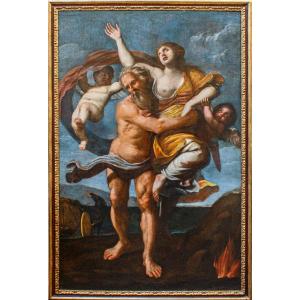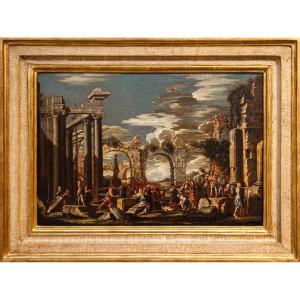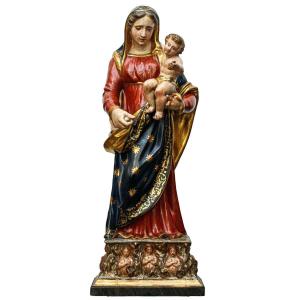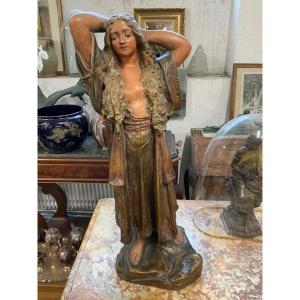Angel
Terracotta, cm 30 x 25
The unfathomability of the divine mystery is evident in the eyes of the present angel, beautifully rendered half-bush and with his hands crossed on the chest, in composed prayerful attitude. The angel, whose title of cherub or seraph cannot be specified given the symbolic commonality with which it is portrayed, has on top of its head a small crowning in which a triangle is recognizable, trinitarian symbol par excellence.
There are numerous traces in the Cremona territory of the great tradition of Lombard Renaissance terracotta, both for the figurative plastic and for architectural decoration; tradition so strongly rooted, also by virtue of the quality and abundance of local clay, To be continued on an industrial scale beyond the middle of the 20th century. The wealth of works and material evidence has facilitated the birth, also in Crema, collections and funds of pottery, in line with the guidelines of national and international collecting of the late nineteenth century and early twentieth. The works of the Renaissance period that have survived to us testify to a high and updated quality level, especially due to the presence in Crema of the great plasticator Agostino de Fondulis.
Together with the numerous attestations of figurative plastic from the fifteenth century, the fittile decorative repertoire of civil and religious buildings in the Lombard Renaissance highlights the happy complementarity between the noble art of «sculpting in terracotta» and the mass production of large-scale architectural ornamentation. In the great works of the early Renaissance, the two forms of plastic creation, expression of a unitary design vision often elaborated and carried out by the same artist, contribute to the realization of complete and separate works of art. The historical events cremasche have led to a progressive alteration, if not destruction, of these native architectural systems - an example on all is the city Cathedral, subject to heavy refaciations eighteenth century. The original heritage of figurative plastic and serially fittile ornamentation in Crema and in the cremasco must often be reconstructed on the basis of documentary evidence and material testimonies that the territory gradually returns following random finds during restoration or excavation. Clay is a material that requires a high level of specialization of the actors involved in the production cycle - the artist responsible for the invention, the plasticians who create the models and forms, the workers involved in the retrieval, the transport and processing of raw materials, furnaces for firing, carpenters and painters on the construction site for commissioning.
From the nineteenth century, the decorative taste of the first Lombard Renaissance - the result of the mixture between a Gothic tradition at its sunset and the free and imaginative elaboration of an ornamental repertoire in the old - finds correspondence in the new addresses of modern architecture, Steeped in historical stress and attentive to the recovery, restoration and maintenance of the remaining Renaissance heritage; interest stimulated by significant technological innovations of a production process able to produce economically material of ever higher quality, but also by important publications at European level of Italian decorative pottery, With particular attention to the buildings in Lombardy.
In 15th century Lombardy, furnaces were often built near the construction sites, as in the case of the decoration of the Portinari Chapel in Sant'Eustorgio in Milan or those of Rinaldo de Staulis for the cloisters of the Certosa in Pavia. The success of the Crema cotto as a material for building and artistic production is due, as in many other centres of Lombardy in the fifteenth century, to the easy availability of raw materials, available near the waterways - in the case of Crema l'Adda, The Serious and the Blue. The clay of the Cremasco territory is characterized by a very light color, hardly found elsewhere. Already in 1490, in the contract of 15 July for the construction of Santa Maria della Croce, entrusted to Giovanni Battagio, son-in-law of Agostino de Fondulis, details of the process for on-site production of the plant materials intended for the new factory are given in detail.
The fundamental role of Winifred Terni de Gregory in the study of Lombard Renaissance terracotta is evidenced by his studies on the de Fondulis family and the architectural decoration in terracotta of Fodri palace in Cremona, defined by her «one of the most typical examples of ancient Lombard palaces». A part of the rich collection of the scholar was donated to the Civic Museum of Crema and Cremasco on 16 June 1962; it includes an interesting core of terracotta both figurative and decorative series, From different eras, as can be seen from the loading log of the Museum.
The object is in good condition
With Ars Antiqua you can defer all amounts up to a maximum of € 7,500 at ZERO RATE, for a total of 15 INSTALLMENTS.
Ex. Tot. € 4,500 = Monthly installment € 300 for 15 months.
Ex. Tot. € 3,600 = Monthly installment € 720 for 5 months.
For amounts over €7,500 or for a longer grace period (over 15 installments), we can provide a custom payment.
Contact us directly to get the best quote.
LIVE TV
- SUNDAY 17.00 - 21.00 Dig.terr. 126 + 809 SKY
- THURSDAY 21.00 - 24.00 Dig.terr. 134 + 809 SKY
- Streaming on our website www.arsantiquasrl.com and on our social networks Facebook and Youtube
All the works proposed by Ars Antiqua are sold accompanied by a certificate of authenticity in accordance with the law and accurate fact sheet.
You can see the works directly at the showroom gallery in Milan, in via Pisacane 55 and 57.
We personally organize transport and deliveries of the works, both for Italy and abroad




































 Le Magazine de PROANTIC
Le Magazine de PROANTIC TRÉSORS Magazine
TRÉSORS Magazine Rivista Artiquariato
Rivista Artiquariato